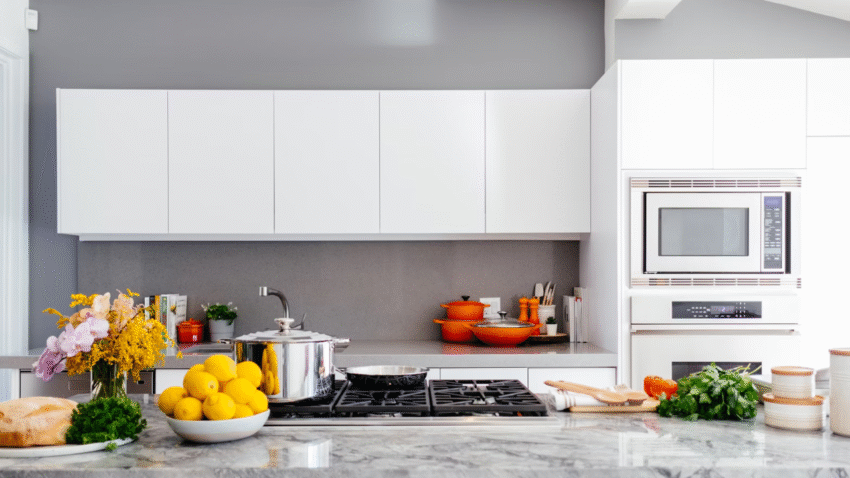Introduction
Greasy kitchen cabinets can make even the cleanest kitchen feel sticky and unpleasant. In this guide, you’ll learn how to clean greasy kitchen cabinets naturally—without relying on harsh chemicals or expensive store-bought products. Struggling to remove that stubborn layer of grime above the stove or around your cabinet handles? You’re not alone, and the good news is you can solve it with simple ingredients from your pantry.
Why Cleaning Greasy Kitchen Cabinets Matters
Grease buildup on cabinets isn’t just unsightly—it also harbors bacteria, attracts dust, and affects the overall hygiene and feel of your kitchen. Over time, layers of cooking oils, steam, and food splatters accumulate on cabinet doors, handles, and corners, turning into a sticky film that’s tough to remove.
By cleaning your cabinets naturally, you:
- Maintain a sanitary prep space
- Extend the life of your cabinet finish
- Create a more inviting kitchen environment
- Eliminate allergens and lingering food odors
Plus, natural solutions are safer for families and pets, and they protect the surface of your cabinets from chemical damage.
Step-by-Step Guide to Cleaning Greasy Cabinets Naturally
Follow these steps for a thorough, chemical-free clean.
1. Gather Your Natural Cleaning Supplies
You’ll need:
- White vinegar
- Baking soda
- Warm water
- Spray bottle
- Microfiber cloths
- Soft-bristle brush or old toothbrush
- Dish soap (optional, natural or eco-friendly)
Kitchen Tip: Avoid abrasive scrubs or steel wool—these can scratch wood or painted finishes.
2. Prepare a Natural Degreasing Solution
Mix the following in a spray bottle:
- 1 part white vinegar
- 1 part warm water
- Optional: A few drops of lemon essential oil for scent and extra grease-cutting power
Shake well. This vinegar-based solution cuts through grease while disinfecting naturally.
3. Spray and Soak
Spray the greasy cabinet surface generously with your solution. Let it sit for 2–3 minutes to soften the grime. For extra buildup near the stove or oven, let the solution sit for up to 5 minutes.
Reminder: Always test the spray on a small hidden area first, especially with painted or wood cabinets.
4. Wipe Away Grease
Using a clean microfiber cloth, wipe down the cabinets. Use small circular motions for stuck-on spots. For detailed areas like grooves or cabinet edges, use a soft toothbrush.
Tip: Rinse your cloth in warm water frequently to avoid spreading the grease around.
5. Tackle Stubborn Grease with Baking Soda
If any grease remains:
- Sprinkle baking soda directly on a damp cloth
- Gently scrub the greasy area
- Rinse with a clean, damp cloth to remove residue
Baking soda acts as a gentle abrasive and deodorizer without damaging the cabinet surface.
6. Dry and Buff
Finish by drying the cabinets with a clean towel. Buff the surface to a natural shine. This also helps prevent streaks or water spots on glossy cabinet finishes.
Optional: For extra shine on wooden cabinets, follow up with a natural oil polish like coconut or olive oil applied sparingly.
Common Mistakes to Avoid
Here are frequent mistakes people make when cleaning greasy cabinets—and how to fix them:
Mistake 1: Using Too Much Water
Solution: Excess moisture can damage wood or seep into cabinet seams. Always wring out your cloth well and dry surfaces promptly.
Mistake 2: Scrubbing with Harsh Pads
Solution: Avoid steel wool or scouring pads. Use a microfiber cloth or soft brush to protect your cabinet finish.
Mistake 3: Skipping the Soaking Step
Solution: Let the vinegar spray sit before wiping. This gives the solution time to break down grease, reducing the need for excessive scrubbing.
Mistake 4: Ignoring Cabinet Handles and Edges
Solution: Grease loves to hide in corners and around handles. Use an old toothbrush or cotton swab for these tight areas.
Mistake 5: Forgetting to Rinse
Solution: Always wipe off any leftover cleaning residue with a clean damp cloth to avoid dulling your cabinet finish over time.
Extra Tips & Kitchen Hacks
Try these additional tips to enhance your cabinet-cleaning routine:
1. Regular Maintenance Wipe-Down
Wipe down cabinet fronts weekly with a damp microfiber cloth and a vinegar-water solution to prevent buildup from forming in the first place.
2. Natural Wood Polish Boost
After cleaning, apply a small amount of olive or coconut oil using a dry cloth. This revives wood’s natural shine and offers mild water resistance.
3. Protect High-Grease Zones
Install a clear adhesive film or use a small shelf liner cut to size above your stove cabinets. These catch grease splatters and can be easily replaced.
Related task to check next: [How to Clean a Greasy Range Hood Filter Naturally]
Conclusion
Cleaning greasy kitchen cabinets naturally is easier than you think. With vinegar, baking soda, and a bit of elbow grease, you can restore shine and hygiene to your kitchen without relying on harsh chemicals. Just remember to soak, scrub gently, and wipe thoroughly. Over time, a simple maintenance habit will keep your cabinets grease-free and your kitchen feeling fresh.
✅ Bookmark this guide to make cabinet cleaning quick and chemical-free every time!
